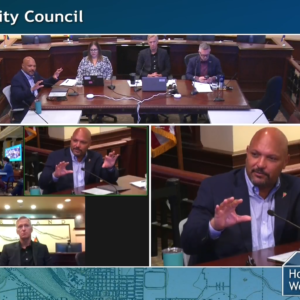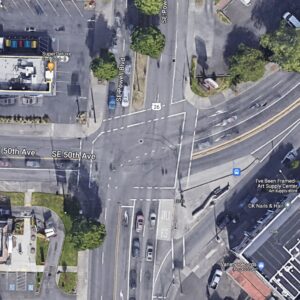
PDOT’s Transportation Options Division has just released an interesting comparison of survey results based on their SmartTrips program. SmartTrips — formerly known as the “Hub” project — is the name given to their annual marketing program that promotes biking, walking, and public transit in a selected geographic area.
In 2006 the target area was Northeast and in 2007 the target area is Southeast (see map at right).
Last September, a post-survey of Northeast residents and the pre-survey of Southeast residents was administered to 900 households; 300 in Northeast and 600 in Southeast.
The most interesting part of the survey is a series of eight statements that asked respondents in both areas if they “Strongly Agree”, “Somewhat Agree”, “Somewhat Disagree”, and “Strongly Disagree.”
Here are the statements:
- In Portland, bikes provide a good means of basic transportation.
- Biking is a good way to take care of errands close to home.
- It is unlikely that I would ever ride a bike to work.
- I am comfortable riding my bike on a street with heavy traffic if there is a bike lane.
- Riding a bike is an important part of my lifestyle.
- I would like to ride a bike more often, but I have trouble fitting it into my current lifestyle.
- Having to share the road with cars and other motor vehicles is the main reason I don’t ride more often.
- I would ride on a streets that have been designed to work well for bicycles even if they are slightly out of my way.
Below are some of the results, followed by excerpts of PDOT’s analysis:

PDOT analysis:
“In NE Portland, 91% of residents either strongly or somewhat agreed that bicycles provide a good means of basic transportation; only 8 percent of the population in NE disagreed. The number for SE were somewhat lower, but still astonishing in terms of the level of potential support for bicycles. Fifty percent of the residents in NE who do not own a bike, strongly agreed with this statement. In both areas, 85% of residents with children agreed and the responses did not vary significantly by gender. 60% of those who strongly disagreed with this statement in NE were over 55 years old (56% in SE).”

PDOT analysis:
“Half of those who strongly agreed that it is unlikely thatthey would ever bike to work were over the age of 55 in both areas. When respondents over 55 years old were removed from the data set, over 63% the population responded favorably to the question.”

PDOT analysis:
“The results indicate that there is broad support among residents for creating bicycle friendly streets, and that such facilities could induce some new riders. However, between and 20-30% of the population would not ride on such facilities. Those respondents who were over 55 years old were split on this issue in NE, with 31% stronlgy agreeing and 24% stronlgy disagreeing; in SE 19% of those over 55 stongly agreed while 37% strongly disagreed.”
For full analysis of all eight statements, download PDOT’s report here (PDF, 90KB). PDOT has also written up a memo that summarizes that report (PDF, 157KB).





Just wanted to note that visually those charts are a little difficult to read properly. You need to look at the numbers to get a sense of what the ratios are. For instance, in both charts, the respondents in SE have a higher “Strongly Agree” response than those in NE. If you just look at them just as graphics, the reverse appears true.
At first, I was scratching my head that it appeared those in SE were more averse to bike riding.
Which, on second read, may in fact be true! Ahhh, graphs.
Yep – the graphs (and tables) would be much clearer had they used the same sample size for both surveys.
Not really following the confusion here, as the numbers are presented as percentages, not actual numbers. Amanda, I think you’re read the graphs backwards…The graphs in the attachmeent are much sharper though, I must say.
Interesting that almost half of the population said they’re willing to ride to work!
A thorough bit of research by whoever in PDOT put this together.
It really dispels the all-to-popular conception that cycling in Portland is supported only by a small minority of politically-connected fanatics.
I’d be interested in seeing the before-and-after statistics for each area. These numbers compare NE after the program to SE before the program. Interesting, but apples and oranges.
I want to know how NE after the program compares to NE responses before the program. What kind of effect is the program having on people’s transportation decisions?
I’ve heard that the program has a high rate of success according to post-program surveys, but is it lasting success? That is, in those neighborhoods that were targeted a few years ago, have those transportation behavioral changes stuck, or did people slowly revert to their old ways after a few winters? How much follow-up is there with the SmartTrips program?
Hi Martha,
You’re correct, these surveys compare NE after our SmartTrips program and SE before. We don’t have any pre data for these 8 questions, but we do have pre/post data for both areas regarding mode choice, trip purpose, and a series of demographics. You can find a full report with those numbers here, http://www.portlandonline.com/transportation/index.cfm?c=43962 , the appendix has the survey data.
We’re also interested in how the program effects perception…which is partially why we started asking these questions. In 2004 we did a “TravelSmart” project in North Portland that showed some really interesting trends with respect to changes in perception after that program, I’d be happy to share those with you, let me know.
Lastly, like you, we are interested in the longevity of these program and are working on getting a follow up survey in place, but it’s expensive! Anecdotally, research done in Australia indicates that the results of the individualized marketing projects decline by about 20%/year because of people change jobs, houses, or living situations.
Dan Bower
Dan,
Thanks for your response. I’m looking forward to seeing the effects of the program in my neighborhood (SE). It sounds like a good program — I’m always amazed at how many people forget (or never realize?) that there’s more than one way to get to where they’re going, so the more people who are out there reminding people to think about their trip (and mode), the better.